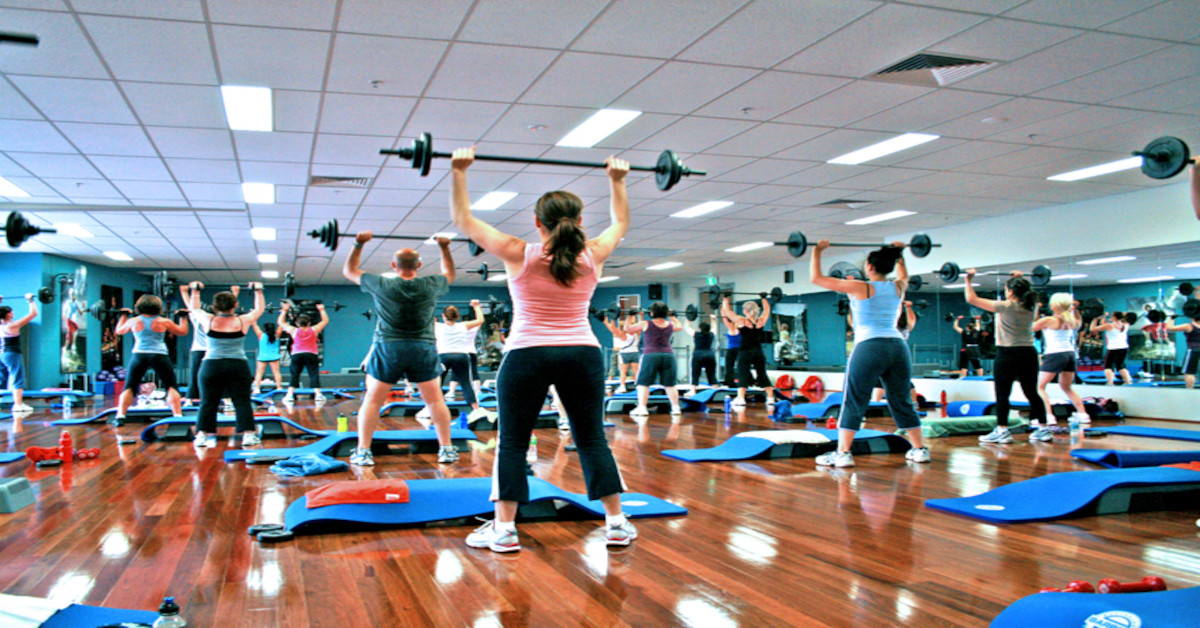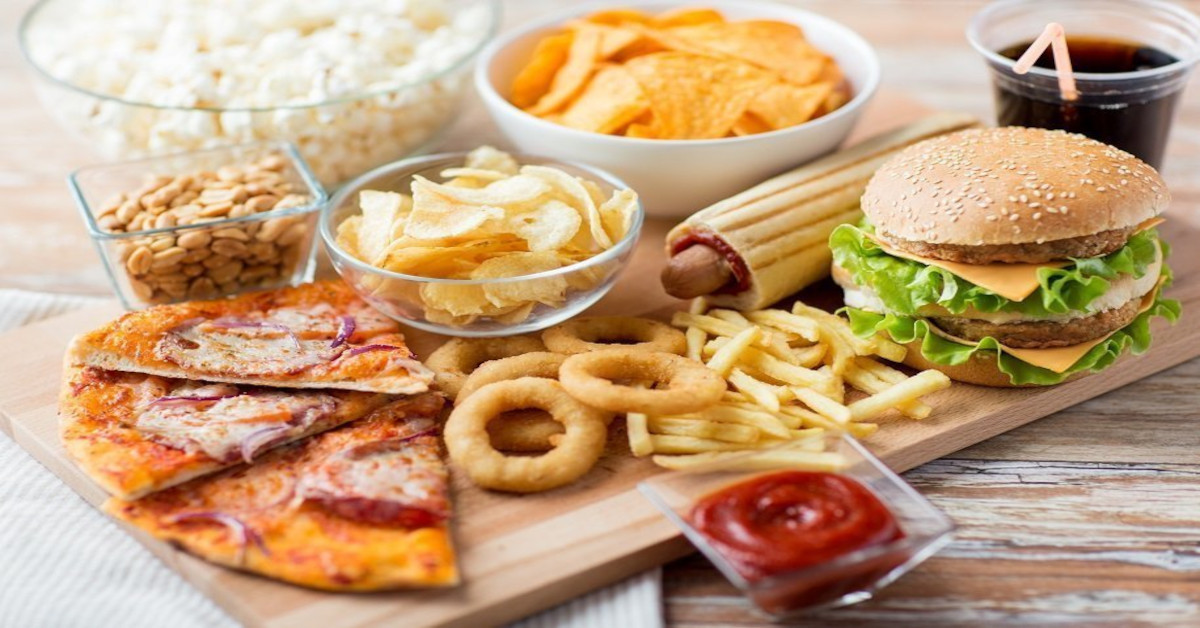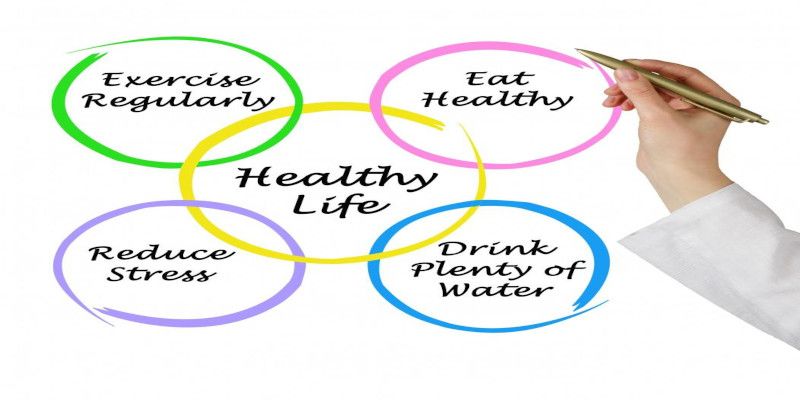Table of Contents
ToggleMost of us acknowledge that there’s a lot we can do and change to keep our physical and mental health in tip-top shape.
Yet, not everyone knows exactly how to leverage that information into positive changes to keep ourselves healthy.
That’s why I compiled the following healthy lifestyle examples and tips to improve your life, and overall health. Let’s get started.
Healthy lifestyle tips
Be physically active and exercise

Human bodies are made to move around and to be physically active. Just take a look at our ancestors. They were continuously hunting, gathering, climbing, fighting other tribes, and running away from hostile animals to survive.
That’s why we need to remain physically active and exercise to remain strong and healthy.
You should perform both strength training and cardiovascular exercise to have both good endurance, and power for all the daily tasks, and to age better.
Try to do something you enjoy whether it’s weightlifting, walking, running, or body weight exercises. What you like doing, are typically the things that you can persist and keep doing forever without any issues.
Watch your weight
A large portion (no pun intended) of our modern society is overweight, which will come as no surprise to many knowing how much great food there is at our disposal today.
Never before have we had this much, and such easy access to delicious, yet unhealthy foods such as fast food, processed food, and sodas that are full of sugar. Our bodies are still hardwired to search out calorie-dense foods since food sources were limited in ancient times.
Thus, our desire to search out calorie-dense food, which is typically unhealthy, is a leftover survival mechanism from our ancestors. That’s why it makes sense to crave foods such as soda, fatty foods, and sweets so much.
But we know that this is unhealthy since it places a lot of extra stress on our cardiovascular system, organs, joints, and muscles. It also increases the risk of attracting debilitating sicknesses such as heart disease, diabetes, and cancers, to name a few. Fortunately, there are a lot of things we can do to lose body fat.
Eat a healthy, varied diet

Eating a healthy, in addition to a varied diet ensures you’re getting all the nutrients you need, all the while keeping you from gaining too much weight.
That’s why you need to eat your vegetables, fruits, meat, and fish to hit both your macro and micronutrients.
Eating cleanly also includes refraining from eating sweets, too much-saturated food, and too much salt. But we’re only human of course. That means that we will succumb to the temptation from time to time. Just make sure not to overdo it, as most things are fine in moderation.
Limit sugar
We know that sugar is a major contributor to inflammation. And that’s not just limited to the joints, but to the organs, and other tissue as well.
Sugar is our primary energy source, signifying that all the sugar that doesn’t get used for physical activity, will get stored as fat instead. That’s why we need to limit sugar as much as possible.
It’s better to have a bit larger of a meal if that keeps you from snacking on sweets and drinking sugary beverages in between meals. Because a healthy meal is at the very least filling, and not full of empty calories.
Limit foods with saturated fats

Saturated fat can be described as a type of dietary fat that is saturated with hydrogen molecules. They are comprised of just singular chemical bonds between carbon atoms.
Many meals contain saturated fats these days. For example, palm oil, butter, sausages, bacon, and biscuits all contain a lot of saturated fat.
Eating too much saturated fat can raise the LDL cholesterol that’s present in your blood. This is commonly known as the “bad” cholesterol in our bodies. This can increase the risk of strokes, and suffering from heart disease.
Eat less salt
Salt in itself isn’t bad. But eating too much salt and sodium can increase blood pressure, which can lead to strokes and heart diseases.
That’s why you shouldn’t put salt on all the foods you eat, which is what a lot of people who like salt do.
Eat fish regularly
Fish is rich in vitamin D, B2, and is full of omega-3 acids. Fish also contains a lot of phosphorus, and calcium, and is filled with minerals like zinc, iodine, iron, potassium, and last but not least, magnesium.
That’s why The American Heart Association advocates eating fish at least twice per week as a component of a healthy, well-balanced diet.
Don’t drink too much alcohol

Drinking too much alcohol can make you do dumb things. Not to mention that it’s dangerous, and unhealthy as well. It is considered a drug that can be highly addictive. Yet, alcohol is socially accepted and even encouraged in some societies.
That’s why alcohol is extremely dangerous, especially to those who are susceptible to addiction, and who don’t drink responsibly.
The Dietary Guidelines for Americans advise that adults should limit alcohol intake to 2 drinks or fewer per day. They recommend that men drink 2 drinks a day at most, and women just 1 drink per day.
Better yet, is to abstain from drinking alcohol altogether. Yet, I’m guilty of enjoying some beers on the weekend as well, even though I’m fully aware of the harmful effects that alcohol can contain. Still, drinking in moderation can aid in limiting the harmful effects.
Drink enough water, stay hydrated
The human body consists of mainly water. Logically, we need enough water to fuel the body, and to keep all the natural processes flowing smoothly.
Drinking enough water prevents overheating, dehydration, kidney stones, and constipation. Furthermore, drinking enough fluids brings nutrients to all the cells in our body, while getting rid of wastes that build up over time.
If we’re dehydrated, we tend to feel sluggish, and less energetic, have trouble focusing, and brain fog might set in as well.
Take a multivitamin
Taking a multivitamin is a good idea for almost everyone since our current eating patterns leave much to be desired.
Even if you do eat a healthy and varied balance, then it’s still likely that you are deficient in some minerals and nutrients such as vitamin D due to the sun not shining every month of the year in most countries.
You shouldn’t overthink this one. Taking a general multivitamin will go a long way towards covering a lot of bases. Supplementing with vitamin D, and fish oil are my go-to’s as well.
Don’t smoke

Smoking has become less and less popular over time. It’s also very expensive to smoke today, and since life is getting increasingly expensive, that money can be put to better use elsewhere.
Smoking is a well-researched topic, and the effects of smoking are clear. Smoking is highly addictive, and very bad for your health. It commonly causes diseases such as lung cancer, lung diseases, heart disease, diabetes type II, and a whole host of other chronic health issues.
It’s both mentally, and physically addictive. The nicotine that’s present in cigarettes is a physically addictive substance, which can make it extremely hard to quit smoking. Mentally, we might associate smoking with a good time, relaxing, and socializing with others. That’s why it’s mentally addictive too because we link it with pleasure and dopamine release.
Manage your stress levels
It’s not just our physical health that we should worry about, but our mental health as well. The mind and body interact. As such, it will come as no surprise that suffering from chronic stress will harm both our mental, and physical health.
That’s why you should learn to control your stress levels. A good general rule is taking action to fix the things you can do something about while trying your best to worry as little as possible about the things you can’t change, and have no control over.
Activities such as yoga, mindfulness, and breathing exercises can help make chronic stressors much more manageable. Sure, they’re not for everyone, but they’re at least worth checking out.
Manage your emotions
Managing your emotions is key to preventing suffering from stress.
Just imagine if you would get worked up about every small thing, such as what people think of you, when you take everything personally, and when something doesn’t go your way.
That’s why you should learn to keep your composure, even when you’re under pressure. This is something that we need to practice to get good at it. But when you do, you’ll be happy that you put in the hours to do so.
Get enough quality sleep

Sleeping is our way to replenish our energy. Sleep is required to function properly. Without it, we feel dull, can’t think properly, feel tired, and can’t concentrate on the task at hand.
To combat this, you’ll need to make sure that you get enough uninterrupted sleep. Aim for at least 8 hours each night, while trying to prevent waking up too many times.
Try to limit electronic devices such as cell phones and computer screens before going to bed. Don’t drink too much water before going to sleep, so you don’t wake up at night because you need to go to the restroom.
Reduce screen time
Reducing screen time can be a good way to maintain our mental health. It’s been shown multiple times by now that too much social media such as Facebook, and Instagram hurts our mental health.
The internet often portrays a perfect and idealistic picture of someone’s life, while the reality is typically much more grim and painful. This can lead to fear of missing out (FOMO) and getting depressed due to feeling the constant need to compare your life to that of others.
Like with most things in life, moderation is key. But if you know you’re prone to comparing yourself with others, and scrolling for hours on end, then it might be best to leave social media altogether.
Protect yourself from the sun

Protecting yourself from the sun is essential to prevent skin issues. Folks who have suffered sunburns in their youth can get skin problems such as skin cancer, skin lesions, and premature aging of the skin.
That’s why you should always wear sun cream to protect yourself from the burning sun. When the sun is out in full force, you should search out the shade, while wearing protective headwear such as a cap, and even sunglasses.
Do regular checkups
Doing regular checkups with your doctor is a good safety precaution. More and more of our current health system is based on preventing issues rather than solving them. Either by providing information or due to detecting diseases sooner by doing more regular checkups.
Getting your blood work done, and searching your skin for potential skin melanomas can go a long way to prevent issues, or to keep them contained.
Personally, I get my blood work done at least once a year. That’s probably still not optimal, but it’s better than never doing so. At the very least, this gives me a better fighting chance if something like cancer should get detected during the processing of my sample.
Practice safe sex

And last but not least, practice safe sex. This might be something we forget during the heat of the moment, but it’s nonetheless essential, especially when it’s not our regular partner we’re having intercourse with.
You can never fully know someone. As a result, you can’t fully trust that they’re not suffering from any sexually transmittable diseases. It’s different when you have a relationship with a steady partner, and when you’re trying to have kids. (Obviously.)
But if you’re just having fun out there, then you should be careful to protect yourself. One wrong decision can alter your life permanently if you’re not cautious.
Different types of lifestyle
Healthy Lifestyle

A healthy lifestyle includes many things such as an active lifestyle, but also eating healthily, moderate portions, and limiting stress among many other things.
Living healthily should be considered the main goal, and is not just limited to an active lifestyle, which is what many folks associate with being healthy. It’s certainly true that it should always be included in a healthy lifestyle, but it’s not limited to just that.
This means learning to resist temptations such as delicious sweets, and the constant need for instant gratification.
Active Lifestyle
An active lifestyle should include both cardiovascular exercise and physical exercise, no matter what age you are.
The activities you do will vary with age. For example, young folks are more likely to do fitness, or body weight exercises than older folks, who are more likely to practice things such as yoga, and going for walks.
But don’t let yourself be put into categories. If you enjoy doing something, then do it. Don’t let yourself be defined by your age, which is just a number in the end. If you enjoy gardening, then be my guest and garden, regardless of what age you are.
Solo Lifestyle

The solo lifestyle has never before been so popular due to the easy access to information, food, and services. Since we live in the digital landscape, many ways exist these days to make money online without ever having to rely on anyone else, except for your loyal customers of course.
But be mindful. Even the most introverted of personalities still need their fair share of social interaction with other people to stay healthy and happy.
Furthermore, you’ll need to be capable of motivating yourself to work, exercise, and socialize. In other words, you’re fully responsible for your own life instead of relying on anyone else.
Urban Lifestyle
The city life is probably best suited for the extroverted personalities who enjoy a busy lifestyle.
This type of living is probably best for those who are looking to acquire material goods since these types typically want to achieve more in life.
If you enjoy non-stop action and a hectic life, then this lifestyle is for you.
Nomadic Lifestyle

Most know the word nomad as someone who travels from one place to another, being constantly on the move instead of settling down. That’s also what the nomadic lifestyle is all about.
Most people don’t tend to find this option an attractive option since most of us crave stability and security.
Unfortunately, that’s not what this lifestyle provides, which means it’s a niche pick. But, it also offers many positives such as flexibility, freedom, and the ability to continuously grow.
Bohemian Lifestyle
The Bohemian lifestyle is a spiritual, and artistic lifestyle.
These types like to seek adventure, typically in forms such as traveling, music, and artistic adventures.
Rural Lifestyle
The rural lifestyle is typically followed in villages. Their daily activities include things such as doing farm-related work, all the while living in close connectivity with Mother Nature.
It’s a peaceful existence, and many people report being much happier, content, and fulfilled living this way. Nevertheless, they have less materialistic goods, less status, and less glamour. But this can be exactly what most people need! Even when we don’t realize it.
Digital Lifestyle

More and more of our lives are spent online through devices such as our cellphones, computers, and social media devices.
This has many positives, but downsides as well. It allows us to be connected with basically anyone from all around the world with just a simple click of a button. But that’s also its biggest downside. The ease of accessibility.
It can cause too little psychological downtime, being too preoccupied with others, and what they think of us. We might also fall prey to comparing our own lives with those of others, and we know that people like to portray their own lives as being better than it is on social media.
Hedonistic lifestyle
A hedonistic lifestyle involves chasing pleasure by going after the instant gratification of our senses by doing things such as drinking excessively, having a lot of sex, smoking a lot, and doing drugs.
It’s doing everything that we enjoy while refraining from doing the things that we should do because they’re hard in addition to challenging.
Alas, hedonism is a lifestyle that isn’t sustainable. At least not in the long run. Eventually, that’ll cause issues with your health since we can’t just mindlessly do things we like while disregarding things we might not enjoy, but are vital to our health such as exercising, eating healthy, and sleeping instead of partying.
Sedentary lifestyle

A sedentary lifestyle is not advised. Human bodies are made to be active. As such, we need to be moving around constantly to be and stay healthy.
Yet, due to modern inventions such as computers, and machines, there’s less need to do the physical activity ourselves, because we can rely on external means to do the work for us. This imparts that an increasingly large number of the population is stuck sitting behind a desk and a screen to do their jobs to pay the bills.
That’s why those who have a fairly sedentary job are well advised to exercise and to take regular breaks to go for a walk and stretch their legs. Even just moving the legs around under the desk can be of assistance to remain fit.
Healthy lifestyle examples
Next up, some healthy lifestyle examples of that are considered good for you, and essential to live a long, flourishing life.
Healthy physical lifestyle examples

Example 1
The first example is when someone decides to exercise and move around a lot while working a desk job all day.
Despite having to sit in front of a computer all day, and the attractive alternative to simply sink in the couch after work, this person decides to work out to keep themselves physically healthy.
It aids them to be strong and to keep a healthy body weight which is vital to stay healthy.
Example 2
Another healthy lifestyle example is when someone decides to watch what they eat. They do their best to eat a large variety of foods such as fruits, vegetables, meats, and fish.
Simultaneously, they refrain from eating processed food, fast food, foods with added salt, and foods rich in sugar. Imagine that the body is a machine, and what we eat is the fuel. When there’s not enough fuel or bad fuel, then the machine will inevitably fail in the end.
That’s why eating a clean, varied diet is such an essential thing to live longer, and more healthily.
Healthy mental lifestyle examples

Example 1
My first healthy mental lifestyle example is someone who prioritizes their own needs and desires to remain content in life.
Instead of continuously putting others’ wants first, they typically put themselves on the forefront to satisfy their desires and needs to be satisfied, content, and happy. A lot of people would consider that selfish and not the way that life should be lived.
However, how can we help others befittingly when we’re not content and satisfied with ourselves? How can we properly help those around us when our mental health isn’t up to par? The answer? We can’t. At least not as well as we could if we would place ourselves more often.
That’s why taking ‘me time’ is required to be and stay mentally healthy.
Example 2
Erik has a busy life. He works 60 hours per week. To make matters worse, he’s working all alone all day long in front of a desk, mostly without seeing other people. When he’s not working, he’s exhausted and at home.
Even though he works many hours, he has mostly no social interaction at work, which is an issue, even if you were to be an introverted person.
Yet, Erik understands how important it is to interact with other people to stay sane. That’s why he makes time on the weekends to invite some friends over to socialize and to have some drinks with them.
Positive lifestyle examples

Positive lifestyle example 1
Amelie has been getting the rough end of the stick recently. She’s been laid off from her job, her mom just passed away, and as a result, she fell into a deep depression.
That’s enough to put most people down for the count. However, she remains optimistic.
Despite all of this, she thinks of her remaining family, wanting to stay strong for her dad and kids. And while she is suffering from a lot of negative thoughts due to her depression, she works hard with a psychologist and by herself to get better. Trying to see the whole experience as a chance to get stronger in the future.
Thus, despite it being an overall very negative and painful experience, she remains positive by looking at the bright side of life and by remaining hopeful.
Positive lifestyle example 2

Meet Victor. Victor is in high school. Unlike most men his age who don’t care about studying. But rather waste their time by having fun chasing women, playing video games, and hanging out with their friends.
Due to this, Victor’s friends tend to procrastinate due to delaying tasks and studying for tests. This makes them experience a lot of stress, which makes them feel anxious and tense.
But Victor is different. While he doesn’t necessarily like studying, he does so diligently, all the while studying in time for his examinations, so he’s prepared. Due to this, he gets good grades and is never late with his school tasks. This is a positive thing since he doesn’t suffer from stress, anxiety, or procrastination.
Frequently Asked Questions (FAQ)
Why do we need a positive lifestyle?

It’ll allow you to stave off devastating mental illnesses such as depression and help you keep your mental health in check. It’ll support your physical health as well because we know that our mental state influences our physical wellbeing.
How do I start a positive lifestyle?
Why is a healthy lifestyle important?

A healthy lifestyle is doing what’s good for your body. It is important to age gracefully and to maintain your ability to do the things you want to do. It aids in preventing chronic diseases and long-term problems.
Likewise, it’s a way of living that can aid you to look better, feel better, and as a consequence, have more confidence, and a higher self-esteem.
What makes a person healthy?
What makes a person healthy is living a healthy, positive lifestyle.
This includes key ingredients such as being physically active, exercising, a healthy diet, getting a good amount of interrupted sleep, and thinking positively.
Nevertheless, many more things are necessary to be healthy. But these components are essential for every individual, even though there’s not a one-size-fits-all solution.
How do I start a healthy lifestyle?

You start a healthy lifestyle by making small, incremental positive changes to your health. It’s all about establishing new, healthy habits and routines.
Think of exercising for 5 minutes, and gradually building up to exercising 1 hour multiple times a week. Or not snacking once a week, until you’re not snacking anymore at all over a longer period.
There are a lot of facets to improve such as sleep, healthy eating, exercising, reducing stress, not smoking, and drinking enough water among many other things.
Final note

These healthy lifestyle examples and tips such as watching your weight, eating a healthy diet, exercising, drinking enough water, and sleeping plenty are essential to stay healthy, and to live a long, flourishing life.
Living your life positively doesn’t mean denying that tragic, negative events happen all around us. It’s about seeing the good and remaining optimistic. Even in bad situations.
Call to action
Aim to make small, incremental, positive changes to your daily routines. This includes doing things such as exercising a few minutes each day, drinking more water, and going to bed a bit sooner instead of staying up late.
It doesn’t need to be perfect from the start, nor will it ever be. But these small changes add up over time and will create a snowball effect.














2 thoughts on “Healthy lifestyle examples: Practical tips to improve your life”
Comments are closed.